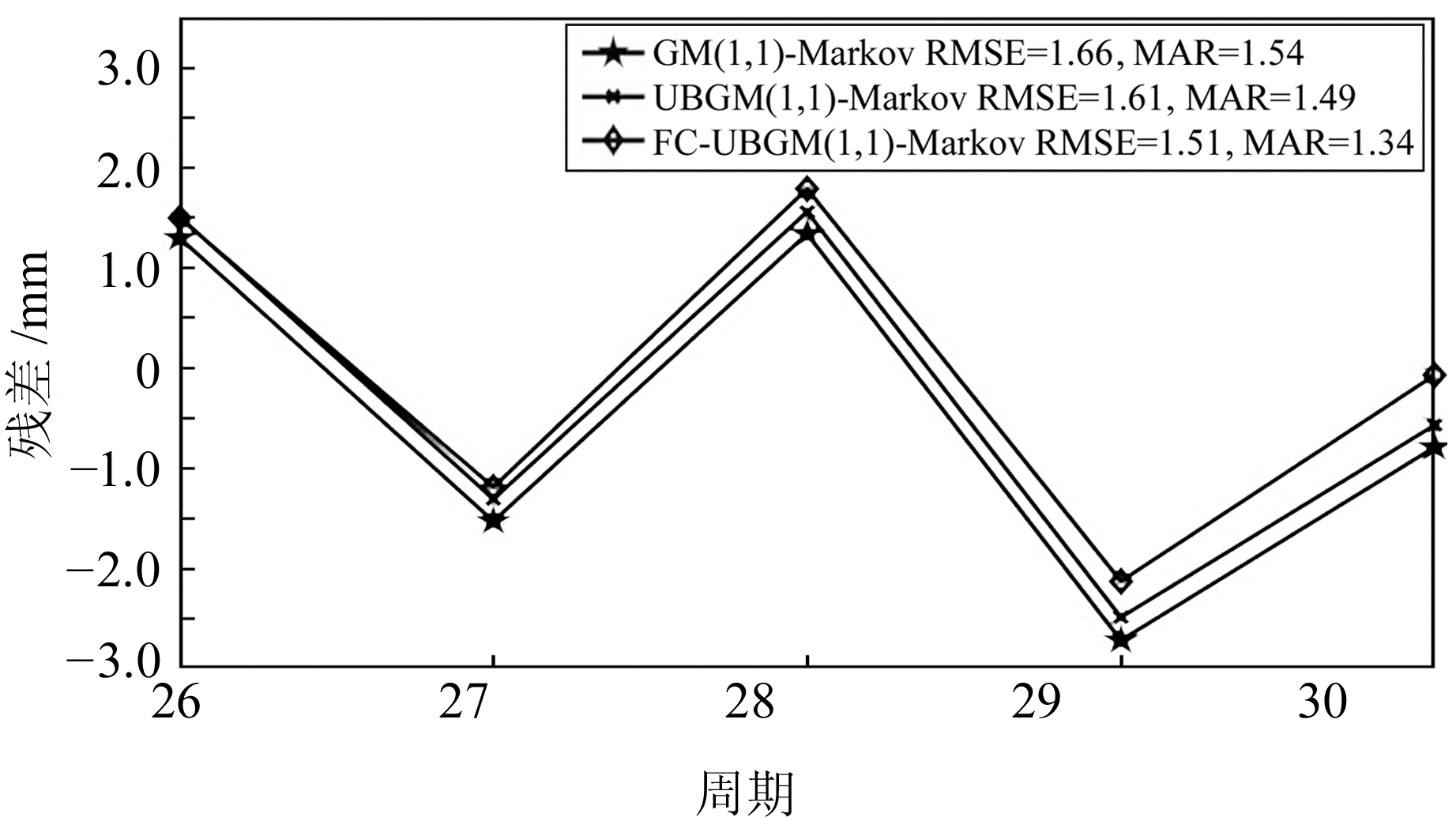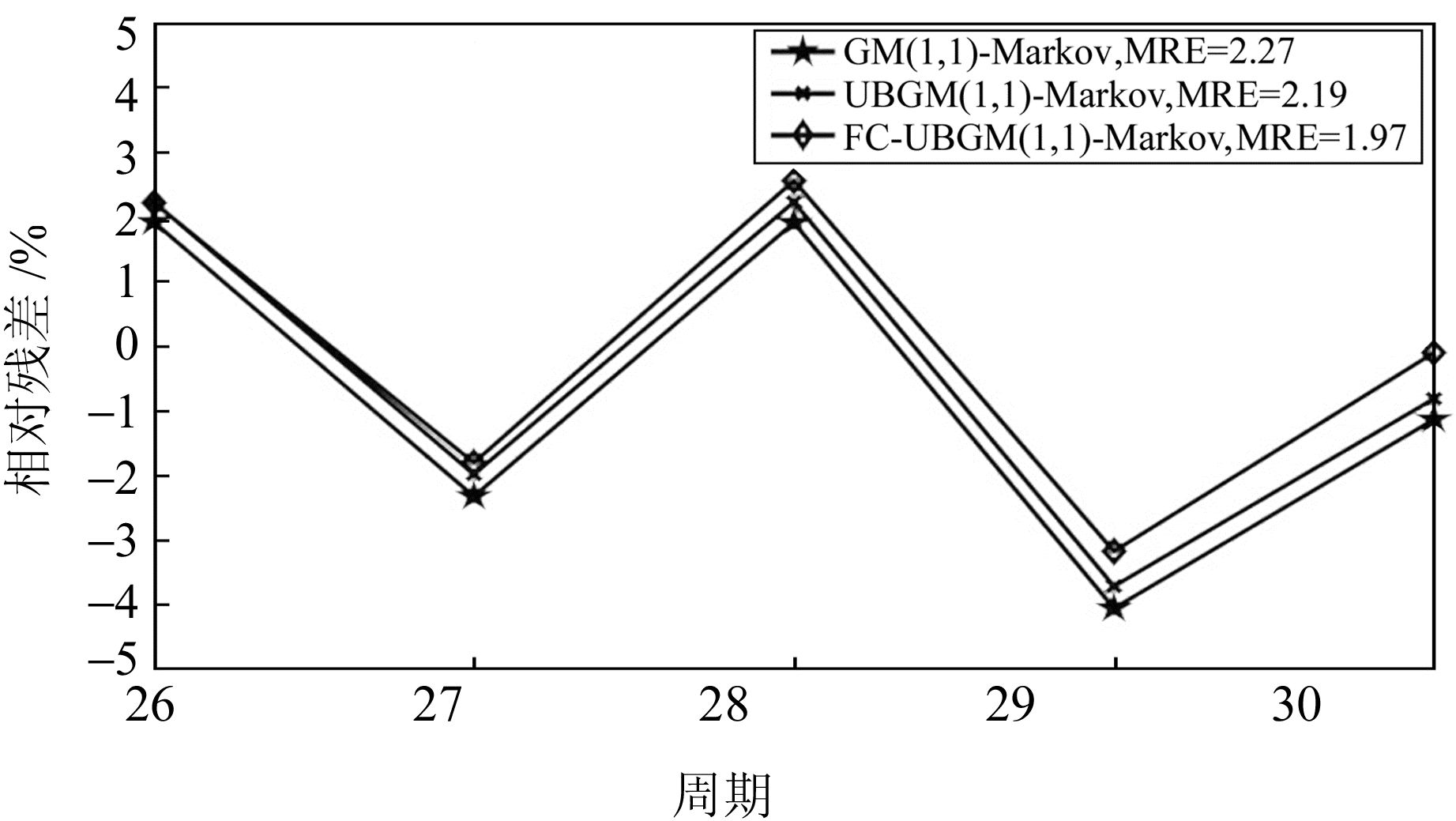2. 中国科学院深圳先进技术研究院,深圳市学苑大道1068号,518055;
3. 辽宁科技大学矿业工程学院,辽宁省鞍山市千山中路189号,114051
UBGM(1, 1)-Markov模型广泛应用于沉降预测[1]。该模型利用UBGM(1, 1)模型消除GM(1, 1)-Markov模型中的灰色固有偏差,提高预测精度。然而,UBGM(1, 1)-Markov预测模型存在2个邻近值可能被归属到不同状态、导致预测值产生偏差的问题。针对该问题,本文引入模糊分类理论,构建了FC-UBGM(1, 1)-Markov预测模型。
1 方法 1.1 模糊分类模糊分类以模糊集合理论为基础,利用数学模型建立事物所属模糊类别的隶属度函数,并根据隶属度大小确定其归属,是一种用于沉降预测的新方法。图 1为利用三角法构建的模糊空间[2],其中E1、E2、E3为3个模糊类别,属于该3个模糊类别的特征值隶属度之和为1。

|
图 1 三角法模糊空间 Fig. 1 Trigonometric fuzzy space |
基于传统GM(1, 1)模型构建的无偏灰色预测模型UBGM(1, 1)为:
| $ {\hat x^{\left( 0 \right)}}\left( k \right) = \left\{ \begin{array}{l} {x^{\left( 0 \right)}}\left( 1 \right), k = 1\\ A{{\rm{e}}^{E\left( {k - 1} \right)}}, k = 2, 3, \cdots , n \end{array} \right. $ | (1) |
式中,
在拟合值的残差ε(0)中,找到满足以下条件的可建模残差尾端序列ε(1)[3]:1)
| $ \hat \varepsilon \left( {k + 1} \right) = \left( { - {a_\varepsilon }} \right)\left( {{\varepsilon ^{\left( 0 \right)}}\left( {{k_0}} \right) - \frac{{{b_\varepsilon }}}{{{a_\varepsilon }}}} \right){{\rm{e}}^{ - {a_ \in }\left( {k - {k_0}} \right)}} $ | (2) |
结合式(1)和(2),构建残差修正后的UBGM(1, 1)模型:
| $ {\hat x^{\left( 0 \right)}}\left( {k + 1} \right) = \left\{ \begin{array}{l} {{\hat x}^{\left( 0 \right)}}, k = 0\\ A{{\rm{e}}^{Ek}}, 0 < k < {k_0}\\ A{{\rm{e}}^{Ek}} \pm \hat \varepsilon \left( {k + 1} \right), k \ge {k_0} \end{array} \right. $ | (3) |
将式(3)拟合值的相对残差序列作为马尔科夫链,划分出n个区间[δi-1, δi](i=1, 2, …, n, n+1),每个区间对应一种状态Ei(i=1, 2, …, n)。把[δi-1, δi]代入模糊分类的隶属度函数[2],计算出模糊向量,向量中的每个分量即是隶属度,根据隶属度最大原则确定其所属状态Ei。通过统计状态Ei之间的一步转移情况,得到一步Markov状态转移概率矩阵p1。
记第k+1期的模糊向量为V(0),该向量V(0)经过l步转移后的模糊向量为V(l),即
| $ {\mathit{\boldsymbol{V}}^{\left( l \right)}} = {\mathit{\boldsymbol{V}}^{\left( 0 \right)}}{\left( {{\mathit{\boldsymbol{p}}^1}} \right)^l} $ | (4) |
利用V(l)确定预测值所属状态Ei,再根据Ei判断该预测值相对残差的区间[δi-1, δi],计算预测值的取值范围[Yi1, Yi2](i=1, 2, …, n),其中,
| $ {Y_{i1}} = \frac{{{{\hat x}^{\left( 0 \right)}}\left( k \right)}}{{1 - {\delta _{i - 1}}}}, {Y_{i2}} = \frac{{{{\hat x}^{\left( 0 \right)}}\left( k \right)}}{{1 - {\delta _i}}} $ | (5) |
那么,经过残差修正后的UBGM(1, 1)-Markov预测值为[Yi1, Yi2]的加权平均值,即
| $ \hat x\left( l \right) = \frac{{{Y_{i1}} + {Y_{i2}}}}{2} $ | (6) |
最后,利用新陈代谢方法将经过残差修正后的UBGM(1, 1)-Markov模型的最新预测值加入到原始序列中,同时剔除最早期的观测数据,再次构建残差修正的UBGM(1, 1)-Markov预测模型,最终得到FC-UBGM(1, 1)-Markov预测值。
2 案例分析 2.1 研究区概况与数据源某露天矿的原最高峰经过露天开采,边坡深切、陡峭,多次发生塌陷。在北边坡变形敏感部位上布设监测点,在南边坡变形范围外稳定的建筑物顶上布设基准点,形成一个长边控制网。采用双频GNSS接收机进行静态相对定位观测,并利用内业数据处理软件对静态观测数据进行基线解算和平差处理,得到沉降观测数据。
以Q3监测点累积沉降观测数据为例,每5 d为一个观测周期, 原始累积沉降量如表 1所示。选取前25期为实验数据,后5期为验证数据。
|
|
表 1 Q3监测点累积沉降量 Tab. 1 Cumulative settlement of monitoring point Q3 |
露天矿边坡沉降速率会随时间变缓,利用弱化缓冲算子对前25期数据进行光滑处理,得到:
| $ d\left( i \right) = \frac{{\mathop \sum \limits_{i = k}^n x\left( i \right)}}{{n - k - 1}}, k = 1, 2, \cdots , n $ |
图 2、3分别为弱化缓冲算子处理前后累积沉降量和周期沉降速率对比。分析图 2可知,原始累积沉降量曲线表明后一期的累积沉降量小于前一期,可能是周围荷载被运走、土质膨胀所致;经过弱化缓冲算子处理后的累积沉降曲线变得平缓,减小了扰动因子的干扰,有利于提高预测精度[4]。分析图 3可知,原始沉降速率曲线表明在监测初期沉降速率较大,但随着监测周期的不断推移,沉降速率逐渐变缓;经过弱化缓冲算子处理后的沉降速率曲线变得平缓。

|
图 2 弱化缓冲算子处理前后累积沉降量对比 Fig. 2 The comparison of cumulative settlements before and after the weakening of the buffer operator |

|
图 3 弱化缓冲算子处理前后沉降速率对比 Fig. 3 The comparison of settlement rates before and after the weakening of the buffer operator |
通过计算UBGM(1, 1)模型的拟合值可知,其19~25期拟合值的残差符号一致。选取k0=19,n=25,并且n-k0=6>4,满足残差修正条件,构建残差修正后的UBGM(1, 1)预测函数为:
| $ \begin{array}{l} {\kern 1pt} {\kern 1pt} {\kern 1pt} {\kern 1pt} {\kern 1pt} {\kern 1pt} {\kern 1pt} {\kern 1pt} {\kern 1pt} {\kern 1pt} {\kern 1pt} {\kern 1pt} {\kern 1pt} {\kern 1pt} {\kern 1pt} {\kern 1pt} {\kern 1pt} {\kern 1pt} {\kern 1pt} {\kern 1pt} {\kern 1pt} {\kern 1pt} {\kern 1pt} {\kern 1pt} {\kern 1pt} {\kern 1pt} {\kern 1pt} {\kern 1pt} {\kern 1pt} {\kern 1pt} {\kern 1pt} {\kern 1pt} {\kern 1pt} {\kern 1pt} {\kern 1pt} {\kern 1pt} {\kern 1pt} {\kern 1pt} {\kern 1pt} {\kern 1pt} {\kern 1pt} {\kern 1pt} {\kern 1pt} {\kern 1pt} {\kern 1pt} {\kern 1pt} {{\hat x}^{\left( 0 \right)}}\left( {k + 1} \right) = \\ \left\{ \begin{array}{l} 39.81, k = 0\\ 44.020{\kern 1pt} {\kern 1pt} {\kern 1pt} {\kern 1pt} {\kern 1pt} {\kern 1pt} {\kern 1pt} 9{{\rm{e}}^{0.016{\kern 1pt} {\kern 1pt} {\kern 1pt} 7\left( k \right)}}, 0 < k < 19\\ 44.020{\kern 1pt} {\kern 1pt} {\kern 1pt} {\kern 1pt} {\kern 1pt} {\kern 1pt} {\kern 1pt} 9{{\rm{e}}^{0.016{\kern 1pt} {\kern 1pt} {\kern 1pt} 7\left( k \right)}} - 0.990{\kern 1pt} {\kern 1pt} {\kern 1pt} {\kern 1pt} {\kern 1pt} {\kern 1pt} {\kern 1pt} 2{{\rm{e}}^{0.063{\kern 1pt} {\kern 1pt} {\kern 1pt} 7\left( {k - 19} \right)}}, k \ge 19 \end{array} \right. \end{array} $ |
残差修正后的UBGM(1, 1)拟合值结果见表 2。根据拟合值的相对残差波动范围将其划分为3个区间:[-8, -1]、(-1, -3]、(-3, 5]。将该3个区间分别代入隶属度函数[2]中,再根据隶属度函数计算每个相对残差的模糊向量,结果见表 2。在模糊向量中,根据其分量的大小(即隶属度)确定每个相对残差所属的状态Ei。那么,根据表 2可得到状态Ei间的一步转移情况,进而得到状态Ei间的一步转移概率矩阵。
|
|
表 2 残差修正后的UBGM(1, 1)拟合值结果 Tab. 2 UBGM(1, 1) fit results of residuals after correction |
由表 2可知,第25期拟合值相对残差的模糊向量为(0.115, 0.885, 0)。然后,利用式(4)分别计算第26~30期预测值相对残差的模糊向量,并根据隶属度最大原则确定其所隶属的状态Ei。最后,通过式(6)计算第26~30期预测值。
利用新陈代谢方法,去掉原始累积沉降序列中的第1期数据,并加入第26期的预测数据。再次进行残差修正的UBGM(1, 1)-Markov过程,最终得到基于FC-UBGM(1, 1)-Markov的第26~30期预测结果,见表 3。
|
|
表 3 预测值结果及与传统模型预测值对比 Tab. 3 Prediction results and comparison with traditional model prediction values |
为了更加直观地比较本文模型与其他传统预测模型的精度,分别计算预测值的残差和相对残差,如图 4、5所示。分析图 4可知,本文模型的残差较其他2种模型的残差更趋近于0,其平均绝对误差(MAR)和均方根误差(RMSE)分别为1.34和1.51。其中,MAR较另外2种模型分别降低12.99%、10.07%;RMSE较另外2种模型分别降低9.04%、6.21%。分析图 5可知,本文模型的相对残差较其他2种模型更趋近于0,其平均相对误差(MRE)为1.97,较另外2种模型分别降低13.22%和10.05%。通过以上分析可知,本文模型的预测效果优于传统模型。

|
图 4 预测值的残差与传统模型对比 Fig. 4 The residual errors of the prediction values compared with traditional models |

|
图 5 Q3监测点预测值的相对残差与传统模型对比 Fig. 5 The relative residuals of prediction values compared with traditional models |
针对传统UGM(1, 1)-Markov模型中存在2个邻近值可能被归属到不同状态的问题,引入模糊分类理论,构建了基于模糊分类的UBGM(1, 1)-Morkov模型。通过露天矿边坡沉降观测数据对该预测模型进行案例分析,结果表明,本文方法的各项精度评价指标均小于传统模型,并且相对于UBGM(1, 1)-Markov模型的RMSE、MAE、MRE分别提高6.21%、10.07%、10.05%,预测效果有一定程度的提高,可用于短期的露天矿边坡沉降预测。
本文不足之处在于,由于监测点位于高陡边坡上,不便于采用精密水准测量的方法进行沉降观测。因此,本实验采用双频GNSS接收机对监测点的沉降进行静态相对定位观测,其观测精度不高,对模型的预测精度分析有一定影响。
未来工作内容:1)克服观测环境因素的影响,选择更加合适的设备和观测方法,提高沉降观测数据的精度;2)不断完善本模型,进一步提高预测精度,并使其可适用于中、长期的沉降预测。
| [1] |
杨帆, 赵增鹏, 王小兵. 改进灰色马尔科夫模型在基坑预测中的研究[J]. 测绘与空间地理信息, 2017, 40(7): 15-18 (Yang Fan, Zhao Zengpeng, Wang Xiaobing. Prediction of Foundation Settlement Prediction Based on Improved Grey Markov Model[J]. Geomatics and Spatial Information Technology, 2017, 40(7): 15-18)
(  0) 0) |
| [2] |
谢建文, 张元标, 王志伟. 基于无偏灰色模糊马尔可夫链法的铁路货运量预测研究[J]. 铁道学报, 2009, 31(1): 1-7 (Xie Jianwen, Zhang Yuanbiao, Wang Zhiwei. Railway Freight Volume Forecasting Based on Unbiased Grey-Fuzzy-Markov Chain Method[J]. Journal of China Railway Society, 2009, 31(1): 1-7)
(  0) 0) |
| [3] |
冯子帆, 成枢, 董娟. 残差修正的GM(1, 1)模型在滑坡位移预测中的应用[J]. 地理空间信息, 2019, 17(9): 113-115 (Feng Zifan, Cheng Shu, Dong Juan. Application of GM(1, 1) Residual Modified Model in Landslide Displacement Prediction[J]. Geospatial Information, 2019, 17(9): 113-115)
(  0) 0) |
| [4] |
王池, 刘超锋, 刘琪. 弱化缓冲算子修正的离散灰色预测[J]. 测绘与空间地理信息, 2019, 42(12): 223-225 (Wang Chi, Liu Chaofeng, Liu Qi. Discrete Grey Prediction Model Revised by Weakening the Buffer Operators[J]. Geomatics and Spatial Information Technology, 2019, 42(12): 223-225)
(  0) 0) |
2. Shenzhen Institutes of Advanced Technology, CAS, 1068 Xueyuan Road, Shenzhen 518055, China;
3. School of Mining Engineering, University of Science and Technology Liaoning, 189 Mid-Qianshan Road, Anshan 114051, China
 2020, Vol. 40
2020, Vol. 40

